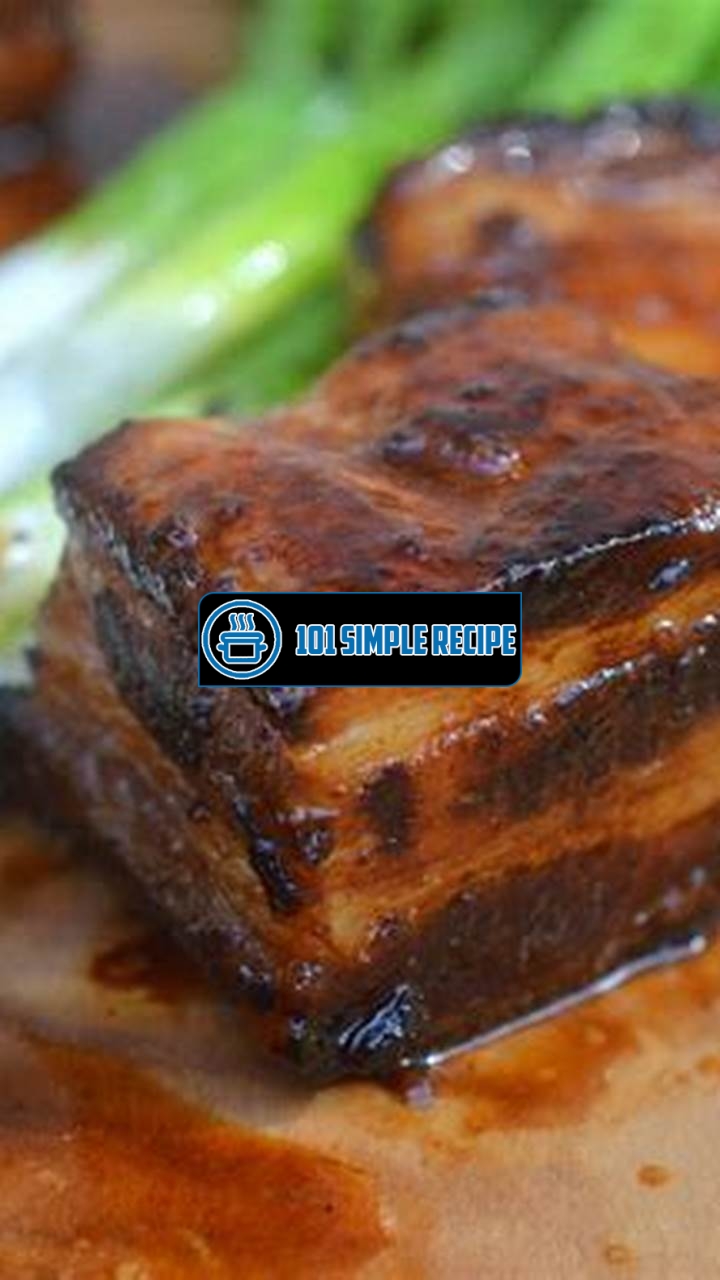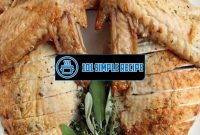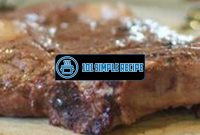Are you craving a tender and succulent pork belly that melts in your mouth? Look no further, because today, we are thrilled to help you discover the perfect sous vide pork belly recipe. ✨
Sous vide cooking has become increasingly popular among home cooks and professional chefs alike. This precise cooking method involves vacuum-sealing the meat and immersing it in a temperature-controlled water bath. The result? Juicy and flavorful pork belly that is guaranteed to impress your taste buds. ️
In this article, we will walk you through the step-by-step process of preparing the most delectable sous vide pork belly. From selecting the finest cut of meat to perfectly seasoning and cooking it to perfection, our expert tips and techniques will ensure your dish is a resounding success. ️
So, grab your apron, put on your chef’s hat, and let’s dive into the world of sous vide cooking to create a mouthwatering masterpiece. Get ready to elevate your culinary skills and savor a truly exceptional pork belly experience.

What is Sous Vide Pork Belly?
Discover the cooking technique of sous vide and its application to pork belly, resulting in a succulent and tender dish.
The Sous Vide Method
The sous vide method is a cooking technique that involves sealing food in a vacuum-sealed bag and cooking it in a temperature-controlled water bath. This method allows for precise control over the cooking temperature, resulting in evenly cooked and tender meat.
When it comes to pork belly, sous vide is the perfect cooking method as it helps to render the fat and break down the tough collagen, resulting in a melt-in-your-mouth texture. The low and slow cooking process of sous vide ensures that the pork belly is cooked to perfection without any risk of overcooking or drying out.
Choosing the Right Pork Belly
When selecting pork belly for sous vide cooking, it is important to choose a piece with a good balance of fat and meat. Look for belly cuts that have an even distribution of fat marbling, as this will help to enhance the flavor and juiciness of the dish.
It is also recommended to choose pork belly that is uniformly thick, as this will ensure that it cooks evenly throughout the sous vide process. Thin strips of pork belly may cook too quickly and become dry, while overly thick cuts may not fully cook in the center.
Additionally, opting for high-quality pork belly from sustainable sources can further enhance the taste and texture of the final dish.
Benefits of Sous Vide Pork Belly
There are several benefits to cooking pork belly using the sous vide method. Firstly, the precise temperature control allows for consistent results every time. The pork belly will be cooked to the exact doneness desired, resulting in a tender and juicy texture.
The slow cooking process of sous vide also helps to tenderize the meat, making it much more enjoyable to eat. The collagen in the pork belly breaks down over time, resulting in a melt-in-your-mouth texture that is hard to achieve with other cooking methods.
Furthermore, the sous vide method allows for easy flavor infusion. By sealing the pork belly in a vacuum-sealed bag, all the flavors and seasonings can infuse into the meat, resulting in a more flavorful dish. Whether you prefer a simple salt and pepper seasoning or a more complex marinade, the sous vide method will help to intensify the flavors.
Overall, sous vide pork belly is a culinary delight that transforms a humble cut of meat into a succulent and tender masterpiece. The precise temperature control, gentle cooking process, and flavor infusion make it a popular choice among food lovers and chefs alike.
Want to try something different? How about this weight loss recipe that’s both healthy and tasty.
Preparing Sous Vide Pork Belly
When it comes to cooking pork belly, using the sous vide method can result in a tender and flavorful dish. This step-by-step guide will walk you through the process of preparing and seasoning pork belly for sous vide cooking, ensuring optimal results every time.
Preparing the Pork Belly
Before you start cooking your pork belly sous vide, it is important to properly prepare the meat. Follow these steps to ensure the best outcome:
- Start by selecting a high-quality piece of pork belly. Look for fresh, well-marbled cuts to ensure maximum flavor and tenderness.
- Remove the pork belly from its packaging and pat it dry with paper towels. This helps to remove any excess moisture, allowing for better seasoning and searing.
- Trim off any excess fat or skin from the pork belly. While some fat is necessary for flavor, trimming off excessive amounts can prevent the meat from becoming greasy during the cooking process.
- Next, slice the pork belly into individual portions. This allows for more even cooking and makes it easier to portion out servings later on.
- Once the pork belly is portioned, you can proceed to season it to your liking.
Seasoning for Flavor
Seasoning plays a crucial role in enhancing the taste of sous vide pork belly. Use the following tips to add depth and flavor to your dish:
- Start by generously coating the pork belly with salt. This helps to enhance the natural flavors of the meat and create a delicious crust.
- Feel free to experiment with other spices and herbs to elevate the flavor profile. Popular choices include garlic powder, paprika, dried thyme, and black pepper.
- Massage the seasonings into the meat, ensuring that every piece is well-coated. This step not only adds flavor but also helps to tenderize the pork belly.
- For an extra boost of flavor, you can marinate the seasoned pork belly overnight in the refrigerator. This allows the flavors to penetrate the meat further.
Vacuum Sealing for Optimal Results
Vacuum sealing the pork belly is a crucial step in sous vide cooking. It helps lock in the flavors and ensures even cooking throughout. Follow these guidelines for the best results:
- Place the seasoned pork belly into a vacuum-sealable bag. Arrange the pieces in a single layer, ensuring they are not overlapping.
- Seal the bag using a vacuum sealer, removing as much air as possible. This creates a tight seal and allows for effective heat transfer during the cooking process.
- If you don’t have a vacuum sealer, you can use a ziplock bag instead. Simply remove as much air as possible before sealing it tightly.
- Before cooking, it is essential to preheat the sous vide water bath to the desired temperature. This ensures that the pork belly cooks evenly and reaches the desired level of doneness.
- Once the water bath is heated, carefully place the sealed bag of pork belly into the water. Make sure it is fully submerged.
By following these steps for preparing and seasoning sous vide pork belly, you’ll be on your way to creating a mouthwatering dish that is tender, flavorful, and sure to impress.
Cooking Sous Vide Pork Belly
Discover the techniques of cooking pork belly using the sous vide method to achieve perfect results every time. Sous vide is a cooking technique that involves vacuum sealing the meat and immersing it in a temperature-controlled water bath for an extended period, resulting in tender and flavorful meat.
Setting the Correct Temperature and Time
When cooking pork belly sous vide, setting the correct temperature and time is crucial to achieve the desired doneness and texture. The recommended temperature for cooking pork belly sous vide is around 145°F (63°C) for a tender and juicy result. However, you can adjust the temperature according to your preferences. Keep in mind that different cuts and thicknesses of pork belly may require slight variations in cooking time.
For optimal results, it is recommended to cook pork belly sous vide for a minimum of 8 hours. This allows the collagen in the meat to break down, resulting in a melt-in-your-mouth texture. However, you can also cook it for up to 24 hours for an even more tender result. Longer cooking times also allow the flavors to develop and intensify.
Immersion Circulator vs. Sous Vide Oven
When it comes to cooking pork belly sous vide, you have the option to use either an immersion circulator or a sous vide oven. Both methods can yield excellent results, but there are some differences to consider.
An immersion circulator is a compact device that you attach to the side of a pot or container filled with water. It heats and circulates the water, maintaining a precise temperature throughout the cooking process. Immersion circulators offer flexibility in terms of container size and are often more affordable compared to sous vide ovens.
On the other hand, a sous vide oven is a standalone appliance that combines a water bath and heating elements in one unit. It provides precise temperature control but is limited to the oven’s size. Sous vide ovens are a convenient option if you frequently cook sous vide and prefer a dedicated appliance.
Ensuring Food Safety in Sous Vide Cooking
Food safety is of utmost importance when cooking sous vide, including when preparing pork belly. Here are some essential tips to ensure food safety:
- Use food-grade vacuum bags: When vacuum sealing the pork belly, ensure you use bags specifically designed for sous vide cooking. These bags are BPA-free and can withstand the high temperatures of the water bath.
- Properly pasteurize the meat: Cooking pork belly sous vide at the recommended temperatures and times ensures that harmful bacteria are eliminated. It is essential to follow safe cooking guidelines to prevent any risks.
- Rapidly chill cooked meat: After cooking the pork belly, rapidly chill it in an ice bath to bring the temperature down to a safe level. This prevents bacterial growth during storage and reheating.
- Store and reheat safely: If you have any leftovers, store them in airtight containers in the refrigerator. When reheating, make sure to reach the proper internal temperature to ensure food safety.
By following these guidelines, you can enjoy delicious and safe sous vide pork belly every time!
For a delicious sous vide pork belly recipe, check out this recipe. It’s a mouthwatering dish that will leave you wanting more.
Serving and Serving Suggestions
When it comes to serving and presenting your sous vide pork belly, the options are endless. By exploring creative plating techniques and pairing the dish with complementary accompaniments, you can elevate your dining experience to a whole new level.
Garnishing and Plating Techniques
Enhance the visual appeal of your sous vide pork belly by utilizing various garnishing and plating techniques. ️ Here are a few ideas to get you started:
- Microgreens and edible flowers: Sprinkle a vibrant mix of microgreens and delicate edible flowers on top of the pork belly to add a pop of color and freshness.
- Pickled vegetables: Slice and pickle a medley of vegetables like radishes, carrots, and cucumbers. These tangy and crunchy additions create a delightful contrast to the rich and tender pork belly.
- Crispy shallots or onions: Fry thinly sliced shallots or onions until golden and crispy. These add an irresistibly crunchy texture to the dish.
- Caramelized fruits: Experiment with caramelizing fruits such as apples or pears in a saucepan. The natural sweetness and slight caramelization create a beautiful balance with the savory pork belly.
Remember, plating is an art form, so don’t be afraid to let your creativity shine. Use different textures, heights, and colors to make the dish visually appealing and appetizing to your guests.
Suggested Sauces and Condiments
To enhance the flavors of your sous vide pork belly, pair it with the perfect sauces and condiments. Here are some recommendations:
- Maple glaze: Brush a maple glaze on the pork belly before searing it to add a hint of sweetness that complements the meat’s richness.
- Hoisin sauce: The sweet and savory notes of hoisin sauce perfectly complement the succulent pork belly. Drizzle it over the dish or serve it on the side.
- Spicy mayo: Create a zesty kick by mixing mayonnaise with a touch of hot sauce or sriracha. This creamy and spicy condiment adds a tangy element to the taste profile of the dish.
- Apple cider reduction: Simmer apple cider until it thickens into a luscious syrup-like consistency. The caramelized apple flavor pairs exceptionally well with the pork belly.
Experiment with different sauces and condiments to find the flavor combination that best complements your sous vide pork belly. Remember, sauces and condiments are versatile, allowing you to tailor the dish to your personal taste preferences. ️
Pairing with Wine and Beer
Completing your sous vide pork belly experience involves finding the right wine or beer to accompany the dish. Here are some pairing recommendations to enhance your culinary journey.
- Pinot Noir: The light body and red fruit flavors of a Pinot Noir make it an ideal wine pairing for pork belly. The acidity helps cut through the richness of the meat.
- India Pale Ale (IPA): If you prefer beer, an IPA with its hoppy bitterness and fruity undertones can balance the fatty nature of pork belly.
- Gewürztraminer: This aromatic white wine offers floral and tropical fruit notes that contrast and complement the flavors of the pork belly.
- Brown Ale: The nutty and caramel flavors of a brown ale enhance the richness of the pork belly, creating a harmonious pairing.
Remember, the art of pairing is subjective, and personal preferences play a significant role. Feel free to explore different wine and beer options to find the combination that excites your taste buds the most. Cheers!
Troubleshooting Sous Vide Pork Belly
During the sous vide cooking process, there may be some common issues that arise. However, with the right knowledge and techniques, you can easily overcome these challenges. In this section, we will address three common problems – ensuring even cooking, dealing with texture variations, and preventing overcooking or undercooking.
Ensuring Even Cooking
One of the primary goals of sous vide cooking is to achieve perfectly even cooking throughout the pork belly. To ensure this, there are a few key factors to consider.
First, make sure that the pork belly is evenly seasoned before vacuum sealing it. This will allow the flavors to meld together and ensure that every bite is delicious. Seasoning with your favorite spices, herbs, and marinades can help elevate the overall taste.
Additionally, it is important to evenly distribute the heat within the water bath. One way to achieve this is by using a sous vide immersion circulator. This device continuously circulates the water, maintaining a consistent temperature throughout. Ensuring that the pork belly is fully submerged in the water will also help in achieving even cooking.
Another tip is to monitor the cooking time carefully. Different sizes of pork belly may require various cooking durations. By following a precise cooking time, you can avoid undercooked or overcooked portions.
Dealing with Texture Variations
Texture variations can sometimes occur when cooking sous vide pork belly. While this can be frustrating, there are ways to address this issue and achieve a uniform texture.
One method is to pre-sear the pork belly before vacuum sealing it. Searing helps to develop a flavorful crust and can enhance browning during the cooking process. This extra step can contribute to a more consistent texture.
Additionally, let the pork belly rest after cooking it sous vide. This resting period allows the juices to redistribute within the meat, resulting in a more even texture.
Experimenting with different cooking times and temperatures can also help in achieving the desired texture. Adjusting these variables can give you more control over the final result, allowing you to customize the texture according to your preference.
Preventing Overcooking or Undercooking
Achieving the perfect level of doneness can be challenging when cooking sous vide pork belly. However, with careful attention to detail, you can prevent the meat from being undercooked or overcooked.
First, it is crucial to precisely set the temperature of the water bath. Ensuring accuracy is key as even a slight difference can affect the outcome. Use a reliable thermometer to monitor and adjust the water temperature throughout the cooking process.
Next, consider the thickness of the pork belly. Thicker cuts will require longer cooking times while thinner slices will cook more quickly. Adjust the cooking duration accordingly to avoid undercooking or overcooking the meat.
Lastly, pay attention to the vacuum-sealing process. A proper seal ensures that the pork belly retains its moisture and texture. Any leaks or gaps can lead to uneven cooking.
In conclusion, troubleshooting sous vide pork belly involves ensuring even cooking, addressing texture variations, and preventing overcooking or undercooking. By following these guidelines and experimenting with different techniques, you can achieve a perfectly cooked and delicious sous vide pork belly every time.
If you’re looking for more sous vide recipes, be sure to try this White Castle recipe. It’s a unique twist on a classic burger.
Thank you for taking the time to read our article on sous vide pork belly. We hope you found the information helpful and inspiring for your next culinary adventure. If you’re craving tender and succulent pork belly with a crispy exterior, sous vide cooking is the perfect technique for achieving outstanding results. Remember to bookmark our page and visit again later for more delicious recipes and cooking tips. Happy cooking! ️
Frequently Asked Questions
Here are some common questions about sous vide pork belly:
| No. | Questions | Answers |
|---|---|---|
| 1. | What is sous vide cooking? | Sous vide cooking is a method that involves vacuum-sealing food in a bag and cooking it in a water bath at a precisely controlled temperature for a longer period of time. This results in perfectly cooked and evenly tender meat, including pork belly. |
| 2. | Can I sous vide pork belly without a vacuum sealer? | Yes, if you don’t have a vacuum sealer, you can use the water displacement method to remove air from the bag. Simply place the seasoned pork belly in a ziplock bag, leaving a small opening, and submerge it in the water bath. The pressure will push out the air, allowing you to seal the bag. |
| 3. | What temperature should I set for sous vide pork belly? | For tender and melt-in-your-mouth pork belly, set the sous vide temperature to 155°F (68°C). Cook it for 12 to 24 hours, depending on the desired tenderness and thickness of the meat. |
| 4. | Can I sear the sous vide pork belly after cooking? | Absolutely! After the sous vide cooking process, remove the pork belly from the bag and pat it dry. Preheat a skillet or grill to high heat and sear the pork belly for a few minutes on each side until it develops a nice crust. This extra step adds a delicious caramelized flavor and crispy texture. |
| 5. | What are some popular seasonings for sous vide pork belly? | Some popular seasonings for sous vide pork belly include soy sauce, garlic, ginger, star anise, and brown sugar. These flavors enhance the natural richness of the pork and create a delightful blend of sweet and savory notes. |
| 6. | Can I use sous vide pork belly in other dishes? | Absolutely! Sous vide pork belly is incredibly versatile and can be used in a variety of dishes. You can slice it and serve it as a main course, use it as a flavorful topping for steamed buns, or even incorporate it into stir-fries and noodle dishes. |
Sous Vide Pork Belly Recipe
If you’re ready to indulge in a mouthwatering pork belly dish, here’s a fantastic recipe to try:
Jump to Recipe
Sous Vide Pork Belly

Learn how to achieve perfectly tender and crispy sous vide pork belly.
- 2 pounds pork belly
- 3 tablespoons soy sauce
- 2 tablespoons brown sugar
- 2 cloves garlic (minced)
- 1 teaspoon grated ginger
- 2 star anise pods
- Preheat your sous vide water bath to 155°F (68°C).
- In a bowl, mix together soy sauce, brown sugar, minced garlic, grated ginger, and star anise pods.
- Place the pork belly in a vacuum-seal bag and pour the marinade over it. Seal the bag using a vacuum sealer.
- Submerge the bag in the preheated water bath and cook for 12 to 24 hours, depending on the desired tenderness.
- After cooking, remove the pork belly from the bag and pat it dry with paper towels.
- Preheat a skillet or grill to high heat. Sear the pork belly for a few minutes on each side until it gets crispy and golden brown.
- Slice the pork belly and serve it as a main course or use it in other dishes of your choice. Enjoy!






